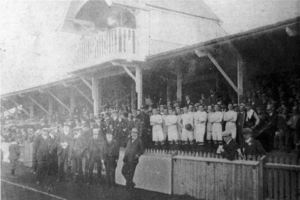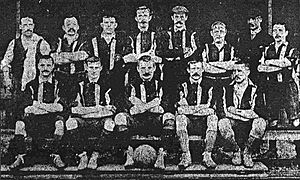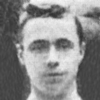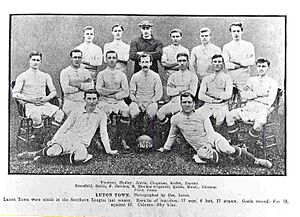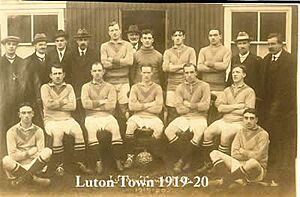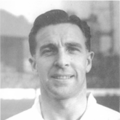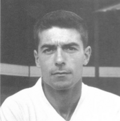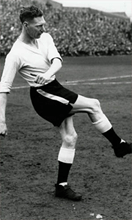History of Luton Town F.C. (1885–1970) facts for kids
Luton Town Football Club is a professional football team from Luton, England. It was started in 1885. Luton Town was the first professional team in the south of England, becoming fully professional by 1891. The club joined The Football League in 1897 but left in 1900 because of money problems. They rejoined the League for the 1920–21 season.
George Thompson became the club's first manager in 1925, but he only stayed for eight months. In 1936–37, Luton was promoted to the Second Division. After World War II, a strong Luton team started to appear. Gordon Turner, who scored many goals for the club, joined in 1950. This helped Luton get promoted to the First Division for the first time in 1954–55.
The team stayed in the top league until they were relegated in 1959–60. Luton also reached the 1959 FA Cup Final in 1959, but they lost 2–1 to Nottingham Forest. After this, the club was relegated three times in six seasons, ending up in the Fourth Division by 1965–66. However, players like Malcolm Macdonald helped the club get promoted twice in three years, and they were back in the Second Division by 1970.
Contents
How Luton Town Started and Became Professional (1885–1900)
Luton Town Football Club was officially formed on 11 April 1885. Before this, there were many smaller football clubs in the town. A player named George Deacon from one of these clubs, Luton Wanderers, had an idea for a "Town" club. This new club would bring together all the best players in Luton.
The secretary of Wanderers, Herbert Spratley, liked the idea. He held a secret meeting in January 1885 to rename Wanderers to Luton Town. However, this was not popular with everyone. George Deacon and John Charles Lomax then set up a public meeting to form a "Luton Town Football Club." Spratley argued that a club already existed. The meeting on 11 April 1885 was tense, but the idea for a new "Luton Town Football Club" was voted for. The team colours were chosen as pink and dark blue shirts and caps.
In the early years, the club played about 35 matches between October and Easter. Most of these were friendly games, but Luton also played in the FA Cup. They didn't have much success in the FA Cup until the 1891–92 season, when they reached the first round.
Luton's biggest achievement was becoming the first professional club in the south of England. At that time, most professional teams were in the north. On 15 December 1890, three players were offered five shillings a week to make up for lost earnings from Saturday morning work. This was to make sure they arrived on time for games. Harry Whitby and Thomas Read were the first to sign, becoming the first professional footballers in the south. In August 1891, the whole team was paid two shillings and sixpence a week, plus expenses.
Luton Town was one of the founding members of the Southern Football League in 1894–95. Their first league match was a 4–3 home loss to Millwall Athletic on 6 October 1894. Millwall won the league that year, and Luton finished second. The next season, 1895–96, Luton finished second again behind Millwall.
After two second-place finishes, Luton tried to join the Football League's Second Division in 1896 but was not chosen. Instead, Luton helped create the United League. This league only had eight teams and didn't last long, causing financial problems for the club. In its first season, 1896–97, Luton finished second behind Millwall for the third year in a row.
The local council planned to build a school where the Dallow Lane ground was. So, the club moved to Dunstable Road in 1897 and became a limited company. The next summer, Luton Town applied to the Football League again and was accepted into the Second Division for the 1897–98 season. They had some success in their first Football League season and also won the United League.
However, their second season in the League was not good, as Luton finished 15th. Their third season was even worse, finishing 17th. Wages were too high, fewer fans were coming to games, and most of the club's money was spent on travel to away matches in the north. So, the club decided to return to the Southern League.
Returning to the Southern League (1900–1919)
The 1900–01 season was the first for winger Bob Hawkes. In the early 1900s, Luton Town finished 10th, seventh, and 11th. In 1903, the club finally made a profit for the first time since becoming professional. The 1904–05 season was tough, with Luton finishing 17th, second from bottom. To make things worse, the club had to leave the Dunstable Road ground quickly.
The club's directors found a new site, and the 1905–06 season started at the new ground, Kenilworth Road. The team was voted back into the Southern League. Luton's first season at Kenilworth Road was a success, with the team finishing fourth. They did this again the next season. Meanwhile, Bob Hawkes, who was captain, was chosen to play for England. He became Luton's first international player.
For the 1907–08 season, new forwards were signed, but goals were still hard to score. Even with a strong midfield of Hawkes, Fred Hawkes, and Fred White, the club dropped to 18th place and lost money. The next year, the team improved to ninth place, but money problems got worse. The forwards finally started scoring in 1909–10, but too many goals were let in at the other end, and the club finished 15th.
The continuing financial issues led to the sale of forwards John Smith and Thomas Quinn to Millwall. By 1910–11, more fans were attending games, finances were getting better, and the club almost won the title, finishing ninth. There was hope for the 1911–12 season, but it ended sadly. Popular defender Sammy Wightman died from injuries he got in a match. High wages, many injuries, and a lack of goals caused the club to be relegated to the Southern League's Second Division.
The club hoped to get promoted straight back in the 1912–13 season. Even with strong new players, the team only finished fifth. The formation of the Luton Town Supporters Club, which raised £60, helped the club stop losing so much money. In 1914, the team finished second and was promoted back to the First Division, just as World War I was about to begin. The 1914–15 season was the last full season before competitive sports mostly stopped. During the war, Ernie Simms, who had been wounded, scored an amazing 40 goals in 1916–17.
Joining The Football League Again (1919–1937)
In the first season after the war, 1919–20, even with Ernie Simms back, Luton finished 20th in the Southern League. Luckily, no clubs were relegated that season. Instead, Luton joined the new Football League Third Division. They also changed their kit colours to white shirts, black shorts, and black socks.
Luton was confident they would be promoted from the new division. They finished ninth in 1920–21 and had a good run in the FA Cup. A record 17,754 fans watched them lose to Preston North End in the FA Cup. Simms scored 34 goals that season, making him the club's top scorer. Luton had such good players that three of them played in an international match on 22 October 1922: Louis Bookman and Allan Mathieson for Ireland, and Ernie Simms for England. Despite this talent, Luton only finished fourth. The main stand at the ground burned down and was rebuilt before the 1922–23 season. Hopes for quick promotion faded as the club finished fifth, seventh, and then 17th.
The 1925–26 season saw George Thompson become Luton's first manager. The club finished eighth, but Thompson left after just eight months. He was not replaced until 1927. The next season, they finished eighth again. After a revolt by shareholders, most of the club's board members were replaced, except for the long-serving chairman, Harry Arnold.
The changes in the boardroom brought hope for 1927–28, but the team finished 13th. Meanwhile, John McCartney, a former player from the 1890s, was appointed manager. It was a season with many goals: the club scored 94 but let in 87. On Boxing Day, Luton was winning 5–1 but ended up losing 5–6. The next year, McCartney led his team to seventh place with help from young Scotsman Andy Rennie. Rennie switched from defence to forward and scored 43 goals in 41 matches. McCartney was often ill, and his assistant George Kay took over in December 1929. The team dropped to 13th place but improved to seventh in 1930–31.
Before the 1931–32 season, Kay left to manage Southampton, and Harold Wightman took his place. Even with skilled players like Frederick Kean, Charles Fraser, and Rennie, the club had many injuries and finished sixth. The next season, Luton finished 14th, perhaps distracted by a good FA Cup run that ended in the sixth round against Everton, who went on to win the cup.
Charles Jeyes, who had been on the board for six years, became chairman in 1933. He made sure the club bought its Kenilworth Road ground. The Bobbers Stand was built that same year, and 18,641 fans watched Luton lose to Arsenal in the cup. Promotion still escaped Luton, and they were denied promotion again in 1934–35. The club finished fourth, mainly because two important players, Bill Brown and Sam Bell, were sold, and Fraser suffered a bad injury.
The 1935–36 season started badly, and Harold Wightman resigned in October 1935. The directors managed the team's affairs, and the club went unbeaten for five months before being knocked out of the cup by Manchester City in January. On 13 April 1936, young Joe Payne was brought into the first team due to injuries. He scored ten goals in a 12–0 win against Bristol Rovers. As of 2013, Payne's ten goals in one match is still a Football League record.
The directors hired Ned Liddle as manager in August 1936. The team finally won promotion on 1 May 1937 with a 2–0 victory over Torquay United. Payne scored both goals that day and 55 goals in 39 games that season. Luton Town won the Third Division South for the first time. The club also beat their rival Watford both at home and away. The clubs would not play each other in the league again until 1963–64.
Life in the Second Division (1937–1955)
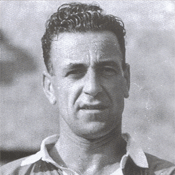
The 1937–38 season was difficult for the club. Luton's first home matches were against big teams like Aston Villa, Manchester United, and Tottenham Hotspur. Luton fought against relegation for most of the season but finished 12th. They reached the fifth round of the FA Cup, losing 3–1 to Manchester City.
Late in the season, manager Ned Liddle left to join Chelsea as a scout, and star forward Joe Payne left days later. Payne's replacement was local player Hugh Billington, who scored 28 goals in the last season before World War II, 1938–39. The club finished seventh under new manager Neil McBain. However, disagreements between McBain and the board led to him leaving after just one season. George Martin was appointed as coach. His Luton team was unbeaten in the first three games of the 1939–40 season, making them top of the Second Division on the day World War II started.
The Football League started again in 1946–47. Martin, who had become manager in 1944, brought in Dally Duncan, a former Scottish international, as player-coach. Martin moved to Newcastle United at the end of a mixed season, and Duncan was promoted to manager. The next four seasons were a time of change. Older players from before the war were slowly replaced by younger ones, often by selling the best players for large fees. Hugh Billington, Frank Soo, Billy Hughes, and Bob Brennan were all sold.
In their place came new Luton players. South African forward Billy Arnison became a fan favourite before an injury sent him home. Home-grown talents like Bob Morton and Gordon Turner helped a new Luton team begin to form.
After losing a lot of money and fewer fans attending games, there wasn't much hope at the start of the 1951–52 season. However, the team's performance improved with the debut of Gordon Turner and the growing skill of players like Syd Owen, Charlie Watkins, and Bob Morton. Luton Town challenged for promotion before finishing eighth and again reached the sixth round of the FA Cup.
1952–53 saw the signing of Jesse Pye. Luton started poorly in the league but then had a great run of results. This was enough to finish third, the club's highest league finish at that time. Pye broke his ankle in December 1953 and missed the rest of the season. Many fans believed the club would have won promotion if he had stayed fit. As it was, the club finished sixth.
After 21 years as chairman, Charles Jeyes stepped down in 1954. In 1954–55, during Percy Mitchell's first season as chairman, promotion to the top league finally happened. Jesse Pye had moved to Derby County after only eight games, but Turner was now skilled enough to take his place. Turner scored a new club record of 32 league goals in 42 games. The team, with talents like Owen, Ron Baynham, Morton, and Turner, marched to promotion. On 30 April 1955, the team won 3–0 at Doncaster Rovers, securing promotion in second place. Mitchell proudly said the club would stay in the top league and planned to build a new ground for 35,000 fans.
Reaching the Top League (1955–1960)
The core players from the 1954–55 promotion team stayed for the club's first season in the top league. Many good performances led to a 10th-place finish in 1955–56. Captain Syd Owen became coach, but he missed three months as a player due to a thigh injury. Other injuries and bad luck stopped them from challenging for the title.
There was only one big signing the next season, as the club focused on developing young players. They finished a respectable 16th. Allan Brown arrived in February from Blackpool for £8,000. Meanwhile, Turner scored 30 league goals and 33 overall the following season, helping the club rise to eighth place in the First Division.
Luton's FA Cup success in 1958–59 hid the start of a decline. Dally Duncan's team was getting older; Syd Owen was already 37 and taking on coaching duties. Duncan left for Blackburn Rovers in October 1958. For the rest of the season, a committee of club directors and coaches managed the team. The club struggled to a 17th-place finish in the league.
However, in the FA Cup, Luton had amazing success. They managed to use the same eleven players all the way to the FA Cup Final. Gordon Turner had lost his place earlier in the season due to injuries. When the directors decided to name an unchanged team for the final, leaving Turner out, it caused a lot of discussion. Luton had beaten Forest 5–1 just weeks before, but on cup final day, the Luton team lost 2–1.
The Cup Final was Syd Owen's last match for Luton, as he was chosen to become manager for the 1959–60 season. His one season in charge was a disaster for the club. Owen complained that the club's directors were not letting him control player transfers and were signing players behind his back. He resigned over this in April 1960. Meanwhile, Luton Town was relegated back to the Second Division, finishing last with only 30 points from 42 games.
Decline and Comeback (1960–1970)
Sam Bartram, a former player, was appointed manager in July 1960. The club had many injured or unhappy players, and many old favourites from the First Division years were sold. The end of the maximum wage for players in football hit the club's money hard. Fewer fans came to games, and the club finished 13th in 1960–61. The next season, a new-look team also finished 13th.
Attendance had dropped to very low levels, and the club was losing £400 a week. Bartram left at the end of the season. Jack Crompton was appointed manager on 29 June 1962 but resigned six days later due to his doctor's advice. A desperate search for a manager ended with Bill Harvey being appointed in late July. Harvey could not stop the club's decline. Luton finished with only 29 points and was relegated to the Third Division. Mitchell was then replaced as chairman by Tom Hodgson.
The club was already in serious relegation trouble in December 1963. However, the signing of a young goalscorer, John O'Rourke, helped improve performances. O'Rourke scored both goals in the last home game of the season against rivals Watford. This stopped Watford from being promoted and ensured Luton stayed in the division.
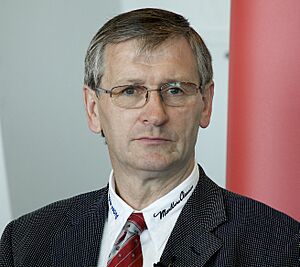
Poor results continued in the 1964–65 season. Harvey resigned as manager and was eventually replaced by George Martin, returning for his second time as Luton manager. Luton finished 21st and was relegated to the Fourth Division for the first time in the club's history.
In 1965–66, Martin worked to improve discipline, and results got much better. Luton finished sixth. The following season marked the club's lowest ever league finish, but also the start of a comeback. Results were bad at first. Allan Brown took over as manager in November as Martin left for a second time. The club was second from bottom of the Football League when Luton lost 8–1 to Lincoln in December. However, the team steadily improved in the new year. Luton finished 17th, and attendance doubled in just a few months.
By the end of 1967, Luton, led by captain Terry Branston, was a changed team. Luton earned 66 points in 1967–68, equalling the division record, and scored 87 goals. Average attendance jumped from 5,364 to 12,400. This helped the club's directors turn down offers from bigger clubs for goal-scoring Bruce Rioch. Rioch scored the only goal at Halifax Town on 20 April 1968 to secure promotion. Four days later, Luton beat Crewe Alexandra in front of 19,000 fans at Kenilworth Road to win the Fourth Division championship.
The 1968–69 season was frustrating, as Luton finished third, just missing out on a second promotion in a row. Brown resigned as manager in December 1968 due to pressure from the board. He was replaced by Alec Stock, who brought Malcolm Macdonald to the club in the summer of 1969. Macdonald was moved from defence to centre-forward and had great success, scoring 25 goals as Luton stormed to a second-place finish in 1969–70. Comedian Eric Morecambe became a director of the club in 1970. Promotion back to the Second Division was secured on the final day of the season with a close 1–0 win over Southport.


